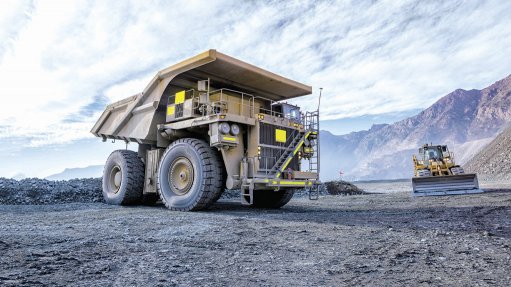
KEEPING TRACK Ctrack’s fleet management system is able to seamlessly integrate with a variety of vehicles through the vehicles’ CAN bus or other inputs
As the mining industry has matured and become more sophisticated, and therefore, more reliant on machinery, the need for precise control of moveable assets has increased drastically, says telematics solutions provider Ctrack.
It cites its “long history” of managing movable assets, its long range of bespoke software solutions, and its locally built hardware, which Ctrack states has “proven to be ideal for harsh mining conditions”.
“The mining industry is a major contributor to South Africa’s gross domestic product and a massive job creator. Ctrack understands the importance of this industry and prides [itself on its ability] to deliver tailor-made solutions that help [the] industry remain profitable, compliant and efficient,” says Ctrack Africa CEO Hein Jordt.
He notes that mining operations rely on a variety of vehicles with various load-carrying capabilities, which are strictly regulated and require specific licences.
“Drivers are required to complete specific training on each class of vehicle before being licensed. Each licence needs to be renewed on a yearly basis, and the renewal process includes a training refresher session. In addition, if an operator does not operate that class of machinery for a period of 180 days, their licence expires and they need to attend a training session to ensure that they are [up to date], before that licence is reinstated.”
These complex licensing requirements mean that driver management with a large team of operators across a wide variety of machinery can be extremely complex.
Consequently, Ctrack has developed a system in which companies can issue drivers a single identification (ID) card for disparate functions, namely facilitating access control and managing vehicle operation.
"The ID card contains information on all the vehicles that an operator is licensed to operate and needs to be swiped before a vehicle can be started. When the driver is trained and licensed for any additional vehicle classes, it is automatically added to their profile,” says Jordt.
This system ensures that fleet managers know exactly who is driving which vehicle when and it also compiles a digital record of all operations. Most importantly it ensures that only appropriately licensed drivers are operating specific vehicles.
Daily reports will alert the fleet manager of licences that are nearing expiry dates, which helps facilitate the administrative aspects related to bookings for training and licence renewals, thereby minimising driver downtime.
Moreover, Ctrack’s SMILE technology – a proprietary scripting language that allows for the development of very specific software solutions with an endless number of options – has enabled the creation of “completely bespoke” solutions for the mining industry.
Jordt cites the example of dust management – an important health and safety and environmental solution that is legally required for a successful mining operation. He notes that specially designed bowsers are used to treat a variety of surfaces, but that each surface requires a different mixture ratio and spray pattern and therefore centimetre precise control is needed when transitioning from one surface to the next.
“Using SMILE technology and precise GPS mapping, Ctrack has been able to completely automate this process, which allows the driver to simply follow the prescribed route with the software-controlled spraying equipment adjusting automatically according to predetermined parameters.”
Another example is where large bulldozers have to move tons of coal towards ‘coal valves’, which drop the commodity onto conveyor belts. Jordt says that steering is often challenging for operators, because of the inherent lack of manoeuvrability of large equipment combined with limited visibility, owing to the design of the dozers’ cab enclosures.
“By implementing and [using] precise geozones, the driver is assisted [using] a series of warning lights as they get closer to the depositing location, which assists them in carefully completing the operation without incident.”
Further, geozones allow for easy monitoring and management of speed and stop-sign violations, as well as enabling monitoring of vehicles in unauthorised locations. The information gained is passed on to drivers as part of their regular training regime.
Ctrack’s fleet management system is also able to seamlessly integrate with a variety of vehicles through the vehicles’ CAN bus or other inputs, affording operators and fleet managers clarity on exactly how the vehicle is used, with all the relevant information displayed on one “easy-to-use” platform.
This includes monitoring of engine performance, fuel consumption, hours in use, as well as any incorporating data from any hardware installed, such as breathalysers or cameras.
Functionality examples include on-board weighing, production and cycle counts, which are invaluable for managing factors such as overloading and half loads, thereby ensuring that assets are used as efficiently as possible.
Mining operations often span large remote areas, which makes visibility of large fleets invaluable, in terms of managing an efficient operation. Consequently, Ctrack offers a variety of hardware that allows for effective tracking of any movable assets, “from dump trucks to non-powered equipment like trailers”.
Managing a large fleet in a dynamic environment also requires specialised fleet management expertise. Ctrack’s Bureau service lets clients access highly trained fleet managers, who monitor all data 24/7, which allows them to both proactively assist in managing operations and tailor solutions as and when the need arises.
“The use of Ctrack’s fleet management system has been proven to ensure control of costs relating to fuel [and production], as well as improving the way in which vehicles are used. [This] ensures compliance, increases productivity and reduces accidents, all of which are critical in running a successful mining operation,” concludes Jordt.